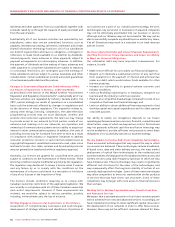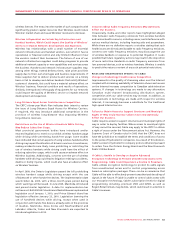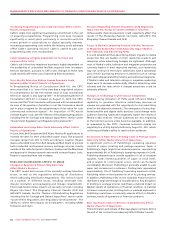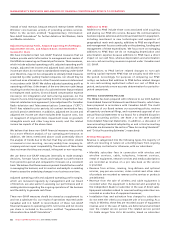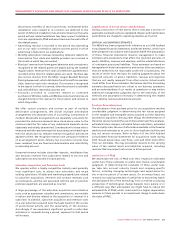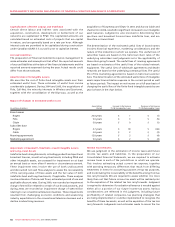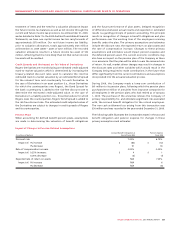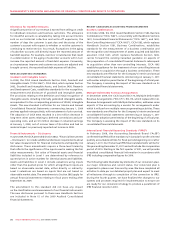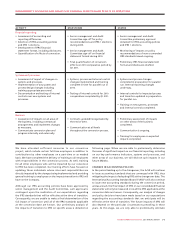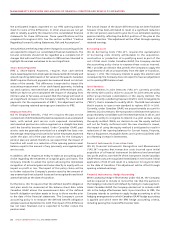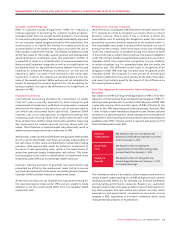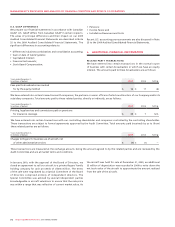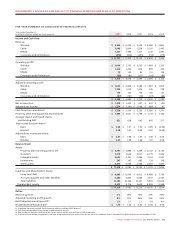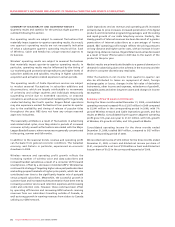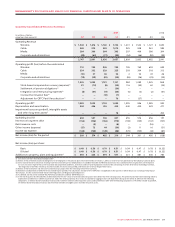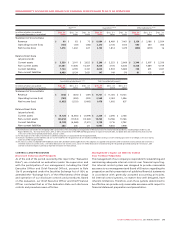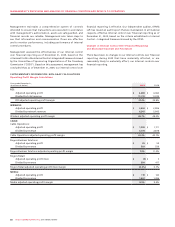Rogers 2009 Annual Report Download - page 66
Download and view the complete annual report
Please find page 66 of the 2009 Rogers annual report below. You can navigate through the pages in the report by either clicking on the pages listed below, or by using the keyword search tool below to find specific information within the annual report.
70 ROGERS COMMUNICATIONS INC. 2009 ANNUAL REPORT
MANAGEMENT’S DISCUSSION AND ANALYSIS OF FINANCIAL CONDITION AND RESULTS OF OPERATIONS
Allowance for Doubtful Accounts
A significant portion of our revenue is earned from selling on credit
to individual consumers and business customers. The allowance
for doubtful accounts is calculated by taking into account factors
such as our historical collection and write-off experience, the
number of days the customer is past due and the status of the
customer’s account with respect to whether or not the customer is
continuing to receive service. As a result, fluctuations in the aging
of subscriber accounts will directly impact the reported amount of
bad debt expense. For example, events or circumstances that result
in a deterioration in the aging of subscriber accounts will in turn
increase the reported amount of bad debt expense. Conversely,
as circumstances improve and customer accounts are adjusted and
brought current, the reported bad debt expense will decline.
NEW ACCOUNTING STANDARDS
Goodwill and Intangible Assets
In 2008, the CICA issued Handbook Section 3064, Goodwill and
Intangible Assets (“CICA 3064”). CICA 3064, which replaces Section
3062, Goodwill and Intangible Assets, and Section 3450, Research
and Development Costs, establishes standards for the recognition,
measurement and disclosure of goodwill and intangible assets.
The provisions relating to the definition and initial recognition of
intangible assets, including internally generated intangible assets,
are equivalent to the corresponding provisions of IAS 38, Intangible
Assets. This new standard is effective for our Interim and Annual
Consolidated Financial Statements commencing January 1, 2009
and was applied retrospectively, with restatement of prior periods.
The adoption of CICA 3064 resulted in a $16 million decrease in
long-term other assets relating to deferred commissions and pre-
operating costs, and an $11 million decrease in retained earnings
at January 1, 2008, net of income taxes of $5 million and had no
material impact on previously reported net income in 2008.
Financial Instruments – Disclosures
In June 2009, the CICA amended Section 3862, “Financial Instruments
– Disclosures”, to include additional disclosure requirements about
fair value measurement for financial instruments and liquidity risk
disclosures. These amendments require a three-level hierarchy
that reflects the significance of the inputs used in making the fair
value measurements. Fair value of financial assets and financial
liabilities included in Level 1 are determined by reference to
quoted prices in active markets for identical assets and liabilities.
Assets and liabilities in Level 2 include valuations using inputs
other than the quoted prices for which all significant inputs are
based on observable market data, either directly or indirectly.
Level 3 valuations are based on inputs that are not based on
observable market data. The amendments to Section 3862 apply for
annual financial statements relating to fiscal years ending after
September 30, 2009.
The amendment to this standard did not have any impact
on the classification and measurement of our financial instruments.
The new disclosures pursuant to these new Handbook Sections
are included in Note 15 of the 2009 Audited Consolidated
Financial Statements.
RECENT CANADIAN ACCOUNTING PRONOUNCEMENTS
Business Combinations
In October 2008, the CICA issued Handbook Section 1582, Business
Combinations (“CICA 1582”), concurrently with Handbook Sections
1601, Consolidated Financial Statements (“CICA 1601”), and 1602,
Non-Controlling Interests (“CICA 1602”). CICA 1582, which replaces
Handbook Section 1581, Business Combinations, establishes
standards for the measurement of a business combination and
the recognition and measurement of assets acquired and liabilities
assumed. CICA 1601, which replaces Handbook Section 1600,
carries forward the existing Canadian guidance on aspects of
the preparation of consolidated financial statements subsequent
to acquisition other than non-controlling interests. CICA 1602
establishes guidance for the treatment of non-controlling interests
subsequent to acquisition through a business combination. These
new standards are effective for the Company’s interim and annual
consolidated financial statements commencing on January 1, 2011
with earlier adoption permitted as of the beginning of a fiscal year.
The Company is assessing the impact of the new standards on its
consolidated financial statements.
Multiple Deliverable Revenue Arrangements
In December 2009, the CICA issued EIC-175, Multiple Deliverable
Revenue Arrangements (“EIC-175”). EIC-175, which replaces EIC-142,
Revenue Arrangements with Multiple Deliverables, addresses some
aspects of the accounting by a vendor for arrangements under
which it will perform multiple revenue-generating activities. These
new standards are effective for the Company’s interim and annual
consolidated financial statements commencing on January 1, 2011
with earlier adoption permitted as of the beginning of a fiscal year.
The Company is assessing the impact of the new standards on its
consolidated financial statements.
International Financial Reporting Standards (“IFRS”)
In February 2008, the Accounting Standards Board (“AcSB”)
confirmed that IFRS will be mandatory in Canada for profit-oriented
publicly accountable entities for fiscal periods beginning on or after
January 1, 2011. Our first annual IFRS financial statements will be for
the year ending December 31, 2011 and will include the comparative
period of 2010. Starting in the first quarter of 2011, we will provide
unaudited consolidated financial information in accordance with
IFRS including comparative figures for 2010.
The following table illustrates key elements of our conversion plan,
our major milestones and current status. Our conversion plan is
organized in phases over time and by area. We have completed all
activities to date per our detailed project plan and expect to meet
all milestones through to completion of the conversion to IFRS.
During the fourth quarter, we have finalized the changes to our
systems and processes required for implementation to ensure we
are ready for our conversion strategy to produce a parallel set of
IFRS financial records in 2010.


